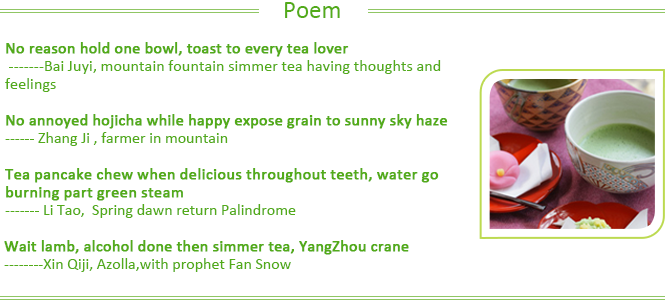
Origin
As one of the first countries in the world to cultivate tea, China has a well established tea culture. Matcha spread quickly amongst the many tea cultures of the world due to its medicinal efficacy, but faded from history as infused tea, and traditional tea-making tools such as millstone gained popularity.
* The Chinese word for Matcha is Mo Cha; Mo is a homophone for grind and powder.

 Ancient Chinese Buddhists were fervent tea drinkers and Japanese tea culture traces its roots to when Buddhism came to Japan. Imperial embassies to China to the Chinese Tang Dynasty and monks who were studying in China brought tea seeds back to Japan and planted them in and around the temples. The people in Aichi Prefecture, where Aiya is based, started to growing tea in 1271. It’s said that the founder of Aichi’s Buddhist temple brought tea seeds from the Song Dynasty in China. Growing tea soon became popular and began spreading. During the Meiji era, Aichi’s abundant water resources, fertile land and warm climate helped officially start the growing of Matcha(tencha). Aiya Japan’s tea plantation there has become one of the very best tea plantation bases in Japan.
Ancient Chinese Buddhists were fervent tea drinkers and Japanese tea culture traces its roots to when Buddhism came to Japan. Imperial embassies to China to the Chinese Tang Dynasty and monks who were studying in China brought tea seeds back to Japan and planted them in and around the temples. The people in Aichi Prefecture, where Aiya is based, started to growing tea in 1271. It’s said that the founder of Aichi’s Buddhist temple brought tea seeds from the Song Dynasty in China. Growing tea soon became popular and began spreading. During the Meiji era, Aichi’s abundant water resources, fertile land and warm climate helped officially start the growing of Matcha(tencha). Aiya Japan’s tea plantation there has become one of the very best tea plantation bases in Japan.

Rich nutrition for your health
 China is where tea drinking began. Tea, as the original nutraceutical beverage, has contributed greatly to not only Chinese dining culture, but to the worlds since antiquity.
China is where tea drinking began. Tea, as the original nutraceutical beverage, has contributed greatly to not only Chinese dining culture, but to the worlds since antiquity.
There are plenty of types of tea, yet Matcha is the best in terms of health benefits; in short, fascination with green powdery Matcha lies in its abundant nutrition and low calories that can be fully digested and absorbed by the body.
A common misconception is that grinding common green tea leaves to get their powder is how Matcha is made, but actually powder from just any green tea leaves does not make Matcha. Though Matcha is powdery and green, the authentic material for making Matcha is the kind of tea that grows protected from direct sunlight, covered on plantations. The finished product is a tea leaf that is darker green, has a richer aroma and a unique sweet and fragrant taste that endures. Almost as amazing as its taste is its spectacular nutritional value with low calories and no cholesterol, fortified with vitamin A, E, K, B1, B2, B6, folic acid, and especially tea polyphenols (catechin), which has been widely touted in the medical science.


 What’s Matcha?
What’s Matcha? 沪公网安备 31011702002169号
沪公网安备 31011702002169号